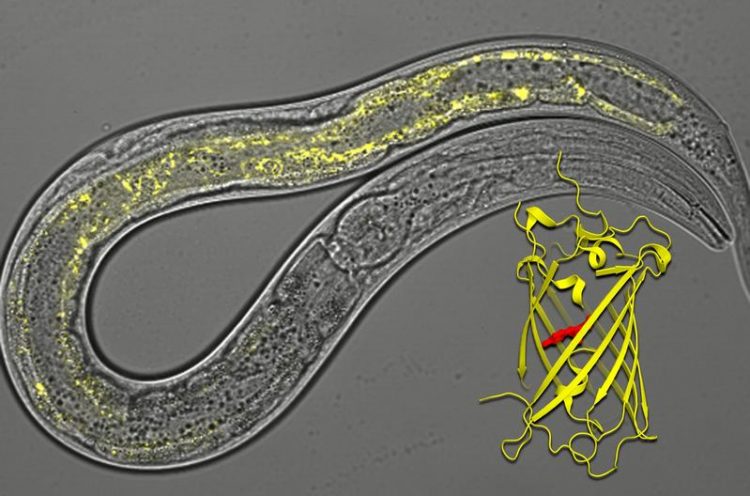Cause of Ageing Remains Elusive

The photo shows a nematode worm with its mitochondria fluorescing in yellow due to sensor staining; a structural model of the probe is shown in the foreground. © Dr. Markus Schwarzländer, Uni Bonn
The Chinese article caused a stir amongst experts worldwide. Using a simple measurement in young nematode worms, the researchers reported they had been able to predict how long they would live .
The researchers had introduced a fluorescent probe called cpYFP into the cellular power stations, the mitochondria, of the worms. Mitochondria are present in most living organisms. They provide the energy for all processes of life.
Many biologists consider the mitochondria an important biological clock that drives ageing. As an underlying cause they suspect that the highly reactive molecules, so called free radicals, released during energy conversion by the power stations can react with cellular molecules causing damage. As a result cellular performance decreases until the cell dies.
This theory is not new – it was first proposed nearly 40 years ago. However, until today it has not been possible to show a conclusive link between mitochondrial activity, the formation of free radicals and ageing. En-Zhi Shen and his colleagues appeared to have found a critical link. They used cpYFP as a free radical detector. And indeed: the more frequently the probe lit up in young worms – i.e. the more free radicals they appeared to produce -, the shorter the worms lived.
An international team of scientists has now refuted a basic assumption of this study. Their work shows that cpYFP is not able to measure free radicals in the first place. Instead the signals of the probe are the result of changes in pH (that is the acidity) inside the mitochondria.
“From the published worm data we cannot conclude that the degree of free radical release determines lifespan.” says Dr. Markus Schwarzländer, research group leader at the University of Bonn and first author of the publication. “cpYFP is not suitable to address this question.” He adds that the relationship between the occurance of the probe signals and lifespan of the worms was exciting nevertheless. “Now we can focus on trying to understand its actual significance.“
The new study is soon to appear, also in the journal Nature. 28 experts from 9 countries were involved in this work. It was led by scientists from the University of Bonn, from the German Cancer Research Center Heidelberg, as well as from the Medical Research Council in Cambridge, England.
Publication: Markus Schwarzländer et al.: The ‘mitoflash’ probe cpYFP does not respond to superoxide; Nature Volume 514 Edition 7523; doi: 10.1038/nature13858
Contact details:
Dr. Markus Schwarzländer
Head of the Emmy-Noether Research Group „Plant Energy Biology“
Institute of Crop Science and Ressource Conservation, University of Bonn
Phone: +40-(0)228-73-54266
E-Mail: markus.schwarzlander@uni-bonn.de
Media Contact
More Information:
http://www.uni-bonn.de/All latest news from the category: Life Sciences and Chemistry
Articles and reports from the Life Sciences and chemistry area deal with applied and basic research into modern biology, chemistry and human medicine.
Valuable information can be found on a range of life sciences fields including bacteriology, biochemistry, bionics, bioinformatics, biophysics, biotechnology, genetics, geobotany, human biology, marine biology, microbiology, molecular biology, cellular biology, zoology, bioinorganic chemistry, microchemistry and environmental chemistry.
Newest articles

A universal framework for spatial biology
SpatialData is a freely accessible tool to unify and integrate data from different omics technologies accounting for spatial information, which can provide holistic insights into health and disease. Biological processes…

How complex biological processes arise
A $20 million grant from the U.S. National Science Foundation (NSF) will support the establishment and operation of the National Synthesis Center for Emergence in the Molecular and Cellular Sciences (NCEMS) at…

Airborne single-photon lidar system achieves high-resolution 3D imaging
Compact, low-power system opens doors for photon-efficient drone and satellite-based environmental monitoring and mapping. Researchers have developed a compact and lightweight single-photon airborne lidar system that can acquire high-resolution 3D…





















